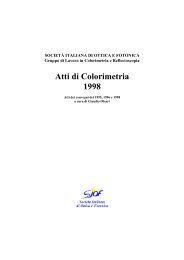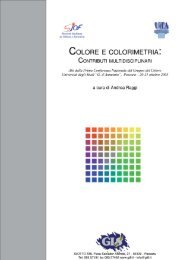Scarica gli atti - Gruppo del Colore
Scarica gli atti - Gruppo del Colore
Scarica gli atti - Gruppo del Colore
You also want an ePaper? Increase the reach of your titles
YUMPU automatically turns print PDFs into web optimized ePapers that Google loves.
considered in the fitness function: the smoothness of the reflectance spectrum is not<br />
an issue, due to the characteristics of the linear mo<strong>del</strong> basis employed. Many<br />
different spectra can generate the same XYZ triplet. If we assume that the<br />
tristimulus values referred to different illuminants are also known, a more effective<br />
fitness function can be designed:<br />
f<br />
* * 2 * * 2 * * 2<br />
[ L − L ) + ( a − a ) + ( b − b ) ] + δ ( R(<br />
λ))<br />
+ δ ( R(<br />
λ))<br />
K<br />
k<br />
(<br />
1<br />
input,<br />
Illk<br />
input,<br />
Illk<br />
input,<br />
Illk<br />
Illk<br />
1<br />
2<br />
= ∑ =<br />
where K is the number of illuminants considered, and the other symbols are those<br />
used in equation (9).<br />
5. Experiments and Results<br />
Different data sets of reflectance functions have been used for benchmarking: the<br />
Macbeth ColorChecker Chart, the whole Munsell Atlas 14, a set of 120 Dupont<br />
paint chips 15 and a set of 1000 silk color samples 16. The following experiments<br />
were performed. For each dataset, given R(λ) we computed the tristimulus values<br />
for three illuminants: D65, A, and F2. Then, for each type of basis set, we<br />
estimated the weights of equation (4) by means of a genetic algorithm using the<br />
fitness function described in (10). We conducted three experiments for each basis<br />
set and for each dataset: one considering only the D65 illuminant, a second<br />
considering the D65 and the A illuminants, and a third considering all three<br />
illuminants (D65, A and F2). The results for the different basis sets are described in<br />
Section 3.<br />
We computed four basis sets by applying Principal Component Analysis to the<br />
datasets used for benchmarking. We then estimated the reflectance spectra for each<br />
dataset, using the corresponding basis set. Table 1 reports the statistics of results<br />
obtained using the PCA basis set of each dataset considered.<br />
In Table 1, the results are reported as average error, maximum error and standard<br />
deviation of the distance in CIELAB space between the coordinates of the<br />
measured and the estimated spectra under the illuminants D65, A, and F2. The<br />
spectral mismatch is reported as the mean absolute error between reflectance<br />
spectra. For each dataset, the first row reports the results for the estimation,<br />
assuming the tristimulus values for the D65 illuminant are available. In this case,<br />
the colorimetric error ΔE D65 is low, while colorimetric errors for the A and F2<br />
illuminants are larger, and indicate that the estimated spectra are metameric with<br />
respect to the original ones. The use of two or three illuminants, as reported in the<br />
second and third row of each dataset, reduces the difference between colorimetric<br />
errors. As a consequence, the spectral error is also reduced. Table 2 reports the<br />
statistics of results obtained using the fitness in equations (10), and the FG basis<br />
set. Table 3 shows the statistics of the results obtained employing the VG basis set.<br />
(10)<br />
153





